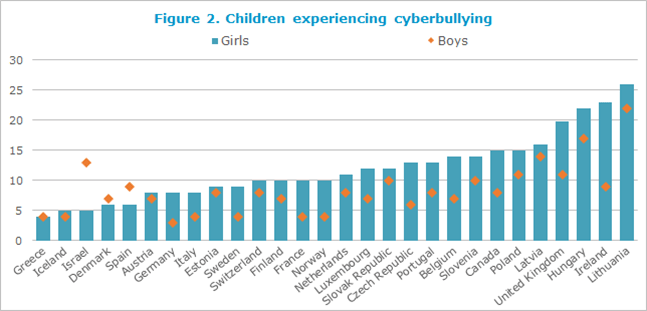by Fabrice Murtin, OECD Statistics and Data Directorate
How does the digital transformation affect women’s and men’s well-being? Digital technologies are radically and rapidly changing the way people work, consume, get information and communicate, but their consequences may differ for women and men. Statistics can help understand whether and how the transformation risks widening the gender gap. This Statistical Insight previews some of the evidence from How’s Life in the Digital Age?(OECD, 2019), which provides a comprehensive overview of how the digital transformation is impacting women and men’s lives.
The digital transformation creates gender gaps in some dimensions of well-being, but the overall impacts on women and men are balanced
The digital transformation doesn’t just affect ICT access and usage. In reality, it entails both opportunities (see Figure 1 Panel A) and risks (Panel B) that affect all the dimensions covered in How’s Life?, the OECD flagship report on people’s well-being.
Overall, Figure 1 suggests that the digital transformation has mixed effects on women relative to men, with women outperforming men on 8 of the 18 indicators. Compared to men, they make greater use of the internet for health purposes (making medical appointments online, seeking health information) and when searching for a job or for social networking. Women also obtain much larger labour market returns for their digital skills (as measured by ICT task-intensity of jobs), and are also much less likely to experience security incidents, abuse of personal information and digital addiction during childhood.
On the other hand, girls are much more likely to be victimised through cyberbullying than boys, and more women than men report that they lack the skills to use e-government services. Similarly, women use online education facilities less than men. They are also less likely to use the internet to buy or sell goods and services, or to express their political opinion. Teleworking is also much less used by women than by men.
Overall, while the digital transformation is affecting the well-being of women and men in broadly similar ways, significant gender gaps are emerging in some specific dimensions of education, work-life balance, health, social connections, governance and digital security. Two specific examples are highlighted below.

Girls are more exposed than boys to cyberbullying
The link between cyberbullying and mental health problems has been extensively documented (Lindert, 2017). On average, across OECD countries with available data, about 12% of girls report having been cyberbullied, compared to 8% for boys. Girls report victimisation more often than boys in all countries except Denmark, Israel and Spain. Cyberbullying is particularly prevalent in a number of Eastern European countries as well as in Ireland and the United Kingdom. Conversely, children in Greece and Iceland report relatively few instances of cyberbullying.

Women telework less than men
Teleworking provides an opportunity for better work-life balance when it improves time management and reduces the time spent in commuting. Evidence from the American Time Use Survey shows, for instance, that reducing commuting time by using the Internet increases labour force participation in the United States, in particular among married women (Dettling, 2016). However, women do not seem to have equal access to teleworking. On average, 20% of male workers reported having teleworked at least once, compared to 16% of women. The gender gap was widest in Luxembourg, Austria, Switzerland and Norway, but very small in Estonia, Hungary and Poland.

Source: OECD calculations based on the Gallup World Poll (www.gallup.com/services/170945/world-poll.aspx).
The measure explained
The new OECD publication How’s Life in the Digital Age? uses the OECD How’s Life? framework to assess the impacts of the digital transformation on 11 key dimensions of people’s well-being (Income and wealth, Jobs and earnings, Housing, Health status, Education and skills, Work-life balance, Civic engagement and governance, Social connections, Environmental quality, Personal security and Subjective well-being). ICT access and use is also included as a cross-cutting aspect of the digital transformation. Drawing on a large number of existing studies, How’s Life in the Digital Age? shows positive impacts of the digital transformation when new technologies expand the range of available information and enhance human productivity and well-being, but also highlights risks ranging from cyber-bullying to overuse or cyber-hacking. It is based on 33 key indicators of the impacts of the digital transformation – 20 to measure digital opportunities and 13 to reflect digital risks.
Among the 18 indicators that allow for a gender breakdown, 13 refer to opportunities and 5 to risks. Altogether they span 9 dimensions of people’s well-being, i.e. ICT access and usage, Education and skills, Income and wealth, Jobs and earnings, Work-life balance, Health status, Social connections, Governance and civic engagement, and Digital security.
For more reading
- OECD (2019), How’s Life in the Digital Age?: Opportunities and Risks of the Digital Transformation for People’s Well-being, OECD Publishing, Paris,https://doi.org/10.1787/9789264311800-en.
- J Lindert; Cyber-bullying and it its impact on mental health: Jutta Lindert, European Journal of Public Health, Volume 27, Issue suppl_3, 1 November 2017, ckx187.581, https://doi.org/10.1093/eurpub/ckx187.581
- Dettling, L. J. (2017). Broadband in the Labor Market: The Impact of Residential High-Speed Internet on Married Women’s Labor Force Participation. ILR Review, 70(2), 451–482. https://doi.org/10.1177/0019793916644721

Pingback: 日本AL学会メルマガVOL106|2019.04.01 – 日本アクティブ・ラーニング学会